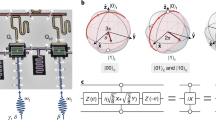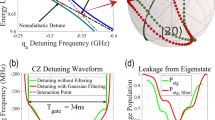Abstract
Near-term applications of quantum information processors will rely on optimized circuit implementations to minimize the circuit depth, reducing the negative impact of gate errors in noisy intermediate-scale quantum (NISQ) computers. One approach to minimize the circuit depth is the use of a more expressive gate set. The XY two-qubit gate set can offer reductions in circuit depth for generic circuits, as well as improved performance for problems with symmetries that match the gate set. Here we report an implementation of the family of XY entangling gates in a transmon-based superconducting qubit architecture using a gate decomposition strategy that requires only a single calibrated pulse. The approach allows us to implement XY gates with a median fidelity of 97.35 ± 0.17%, approaching the coherence-limited gate fidelity of the two-qubit pair. We also show that the XY gate can be used to implement instances of the quantum approximate optimization algorithm, achieving a reduction in circuit depth of ~30% compared with the use of CZ gates only. Finally, we extend our decomposition scheme to other gate families, which can allow for further reductions in circuit depth.
This is a preview of subscription content, access via your institution
Access options
Access Nature and 54 other Nature Portfolio journals
Get Nature+, our best-value online-access subscription
$29.99 / 30 days
cancel any time
Subscribe to this journal
Receive 12 digital issues and online access to articles
$119.00 per year
only $9.92 per issue
Buy this article
- Purchase on Springer Link
- Instant access to full article PDF
Prices may be subject to local taxes which are calculated during checkout





Similar content being viewed by others
Data availability
The experimental data and circuits used for the QAOA experiment are provided in ref. 54.
Code availability
The code used for data analysis is provided in ref. 54.
References
Preskill, J. Quantum computing in the NISQ era and beyond. Quantum 2, 79 (2018).
Otterbach, J. S. et al. Unsupervised machine learning on a hybrid quantum computer. Preprint at https://arxiv.org/pdf/1712.05771.pdf (2017).
McCaskey, A. J. et al. Quantum chemistry as a benchmark for near-term quantum computers. npj Quantum Inf. 5, 99 (2019).
Hong, S. S. et al. Demonstration of a parametrically activated entangling gate protected from flux noise. Phys. Rev. A 101, 012302 (2020).
Andersen, C. K. et al. Entanglement stabilization using ancilla-based parity detection and real-time feedback in superconducting circuits. npj Quantum Inf. 5, 69 (2019).
Quantum devices & simulators. IBM https://www.research.ibm.com/ibm-q/technology/devices/ibmqx4 (2018).
Barends, R. et al. Superconducting quantum circuits at the surface code threshold for fault tolerance. Nature 508, 500–503 (2014).
Sheldon, S., Magesan, E., Chow, J. M. & Gambetta, J. M. Procedure for systematically tuning up cross-talk in the cross-resonance gate. Phys. Rev. A 93, 060302 (2016).
Barends, R. et al. Diabatic gates for frequency-tunable superconducting qubits. Phys. Rev. Lett. 123, 210501 (2019).
Peterson, E. C., Crooks, G. E. & Smith, R. S. Two-qubit circuit depth and the monodromy polytope. Quantum 4, 247 (2020).
Vidal, G. & Dawson, C. M. Universal quantum circuit for two-qubit transformations with three controlled-NOT gates. Phys. Rev. A 69, 010301 (2004).
Shende, V. V., Markov, I. L. & Bullock, S. S. Minimal universal two-qubit controlled-NOT-based circuits. Phys. Rev. A 69, 062321 (2004).
Schuch, N. & Siewert, J. Natural two-qubit gate for quantum computation using the XY interaction. Phys. Rev. A 67, 032301 (2003).
Siewert, J. & Fazio, R. Quantum algorithms for Josephson networks. Phys. Rev. Lett. 87, 257905 (2001).
Kempe, J., Bacon, D., DiVincenzo, D. P. & Whaley, K. B. Encoded universality from a single physical interaction. Quantum Inf. Comput. 1, 33–55 (2001).
Echternach, P. et al. Universal quantum gates for single Cooper pair box based quantum computing. Quantum Inf. Comput. 1, 143–150 (2001).
Ganzhorn, M. et al. Gate-efficient simulation of molecular eigenstates on a quantum computer. Phys. Rev. Appl. 11, 044092 (2019).
Hadfield, S. et al. From the quantum approximate optimization algorithm to a quantum alternating operator ansatz. Algorithms 2019, 34 (2019).
Wang, Z., Rubin, N. C., Dominy, J. M. & Rieffel, E. G. XY mixers: analytical and numerical results for the quantum alternating operator ansatz. Phys. Rev. A 101, 012320 (2020).
Knill, E., Laflamme, R., Martinez, R. & Tseng, C. An algorithmic benchmark for quantum information processing. Nature 404, 368–370 (2000).
Strauch, F. W. et al. Quantum logic gates for coupled superconducting phase qubits. Phys. Rev. Lett. 91, 167005 (2003).
Majer, J. et al. Coupling superconducting qubits via a cavity bus. Nature 449, 443–447 (2007).
Dewes, A. et al. Characterization of a two-transmon processor with individual single-shot qubit readout. Phys. Rev. Lett. 108, 057002 (2012).
Bertet, P., Harmans, C. J. P. M. & Mooij, J. E. Parametric coupling for superconducting qubits. Phys. Rev. B 73, 2–7 (2005).
Niskanen, A. O. et al. Quantum coherent tunable coupling of superconducting qubits. Science 316, 723–726 (2007).
McKay, D. C. et al. Universal gate for fixed-frequency qubits via a tunable bus. Phys. Rev. Appl. 6, 064007 (2016).
Roth, M. et al. Analysis of a parametrically driven exchange-type gate and a two-photon excitation gate between superconducting qubits. Phys. Rev. A 96, 062323 (2017).
Didier, N., Sete, E. A., da Silva, M. P. & Rigetti, C. Analytical modeling of parametrically modulated transmon qubits. Phys. Rev. A 97, 022330 (2018).
Caldwell, S. A. et al. Parametrically activated entangling gates using transmon qubits. Phys. Rev. Appl. 10, 034050 (2018).
Mundada, P., Zhang, G., Hazard, T. & Houck, A. Suppression of qubit crosstalk in a tunable coupling superconducting circuit. Phys. Rev. Appl. 12, 054023 (2019).
Naik, R. K. et al. Random access quantum information processors using multimode circuit quantum electrodynamics. Nat. Commun. 8, 1904 (2017).
Yan, F. et al. Tunable coupling scheme for implementing high-fidelity two-qubit gates. Phys. Rev. Appl. 10, 054062 (2018).
Vaughan, R. W., Elleman, D. D., Stacey, L. M., Rhim, W. & Lee, J. W. A simple, low power, multiple pulse NMR spectrometer. Rev. Sci. Instrum. 43, 1356–1364 (1972).
Kimmel, S., Low, G. H. & Yoder, T. J. Robust calibration of a universal single-qubit gate set via robust phase estimation. Phys. Rev. A 92, 062315 (2015).
Magesan, E. et al. Efficient measurement of quantum gate error by interleaved randomized benchmarking. Phys. Rev. Lett. 109, 080505 (2012).
Dvoretzky, A., Kiefer, J. & Wolfowitz, J. Asymptotic minimax character of the sample distribution function and of the classical multinomial estimator. Ann. Math. Stat. 27, 642–669 (1956).
Birnbaum, Z. W. & McCarty, R. C. A distribution-free upper confidence bound for Pr{Y < X}, based on independent samples of X and Y. Ann. Math. Stat. 29, 558–562 (1958).
Massart, P. The tight constant in the Dvoretzky–Kiefer–Wolfowitz inequality. Ann. Probab. 18, 1269–1283 (1990).
Didier, N., Sete, E. A., Combes, J. & da Silva, M. P. AC flux sweet spots in parametrically modulated superconducting qubits. Phys. Rev. Appl. 12, 054015 (2019).
Merkel, S. T. et al. Self-consistent quantum process tomography. Phys. Rev. A 87, 062119 (2013).
Farhi, E., Goldstone, J. & Gutmann, S. A quantum approximate optimization algorithm. Preprint at https://arxiv.org/pdf/1411.4028.pdf (2014).
Abrams, D. M., Didier, N., Caldwell, S. A., Johnson, B. R. & Ryan, C. A. Methods for measuring magnetic flux crosstalk between tunable transmons. Phys. Rev. Appl. 12, 064022 (2019).
Wang, Z., Hadfield, S., Jiang, Z. & Rieffel, E. G. Quantum approximate optimization algorithm for maxcut: a fermionic view. Phys. Rev. A 97, 022304 (2018).
Qiang, X. et al. Large-scale silicon quantum photonics implementing arbitrary two-qubit processing. Nat. Photon. 12, 534–539 (2018).
Verdon, G. et al. Learning to learn with quantum neural networks via classical neural networks. Preprint at https://arxiv.org/pdf/1907.05415.pdf (2019).
Babbush, R. et al. Low-depth quantum simulation of materials. Phys. Rev. X 8, 011044 (2018).
Kivlichan, I. D. et al. Quantum simulation of electronic structure with linear depth and connectivity. Phys. Rev. Lett. 120, 110501 (2018).
Crooks, G. E. Performance of the quantum approximate optimization algorithm on the maximum cut problem. Preprint at https://arxiv.org/pdf/1811.08419.pdf (2018).
O’Gorman, B., Huggins, W. J., Rieffel, E. G. & Whaley, K. B. Generalized swap networks for near-term quantum computing. Preprint at https://arxiv.org/pdf/1905.05118.pdf (2019).
Barenco, A. et al. Elementary gates for quantum computation. Phys. Rev. A 52, 3457–3467 (1995).
Reed, M. D. et al. Realization of three-qubit quantum error correction with superconducting circuits. Nature 482, 382–385 (2012).
Fedorov, A., Steffen, L., Baur, M., da Silva, M. P. & Wallraff, A. Implementation of a Toffoli gate with superconducting circuits. Nature 481, 170–172 (2012).
Mariantoni, M. et al. Implementing the quantum von Neumann architecture with superconducting circuits. Science 334, 61–65 (2011).
Abrams, D., Didier, N., Johnson, B., da Silva, M. P. & Ryan, C. Ancillary files for paper: Implementation of the XY interaction family with calibration of a single pulse. Zenodo https://zenodo.org/record/3568420 (2019).
Nersisyan, A. et al. Manufacturing low dissipation superconducting quantum processors. Preprint at https://arxiv.org/pdf/1901.08042.pdf (2019).
Jones, G. et al. Scalable instrumentation for general purpose quantum computers. In American Physical Society March Meeting 2019 abstr. V26.00011 (APS, 2019).
Acknowledgements
Work at the Molecular Foundry was supported by the Office of Science, Office of Basic Energy Sciences, of the US Department of Energy under contract no. DE-AC02-05CH11231. We thank the Rigetti quantum software team for providing tooling support, the Rigetti fabrication team for manufacturing the device, the Rigetti technical operations team for fridge build out and maintenance, the Rigetti cryogenic hardware team for providing the chip packaging, and the Rigetti control systems and embedded software teams for creating the Rigetti AWG control system. We additionally thank M. Scheer and E. Peterson for convincing us that the composite pulse decomposition would be a valid implementation of the XY gates. We thank P. Karalekas for his help in setting up the QAOA demo. Finally, we thank Z. Wang, N.C. Rubin, E.G. Rieffel and D. Venturelli for valuable conversations.
Author information
Authors and Affiliations
Contributions
D.M.A., C.A.R. and M.P.d.S. drafted the manuscript, puzzled out the implementation of frame phases and brainstormed effective ways to benchmark the gate. D.M.A. performed the experiments. N.D. provided theory to describe the turn-on phase of shaped flux pulses and the formula for the coherence-limited gate fidelity. B.R.J., C.A.R. and M.P.d.S. organized the effort.
Corresponding author
Ethics declarations
Competing interests
N.D. is an employee of Rigetti Computing. All other authors declare no competing interests.
Additional information
Publisher’s note Springer Nature remains neutral with regard to jurisdictional claims in published maps and institutional affiliations.
Extended data
Supplementary information
Rights and permissions
About this article
Cite this article
Abrams, D.M., Didier, N., Johnson, B.R. et al. Implementation of XY entangling gates with a single calibrated pulse. Nat Electron 3, 744–750 (2020). https://doi.org/10.1038/s41928-020-00498-1
Received:
Accepted:
Published:
Issue Date:
DOI: https://doi.org/10.1038/s41928-020-00498-1
This article is cited by
-
Extensive characterization and implementation of a family of three-qubit gates at the coherence limit
npj Quantum Information (2023)
-
Noisy intermediate-scale quantum computers
Frontiers of Physics (2023)
-
Scalable algorithm simplification using quantum AND logic
Nature Physics (2023)
-
High fidelity two-qubit gates on fluxoniums using a tunable coupler
npj Quantum Information (2022)
-
Constrained quantum optimization for extractive summarization on a trapped-ion quantum computer
Scientific Reports (2022)



